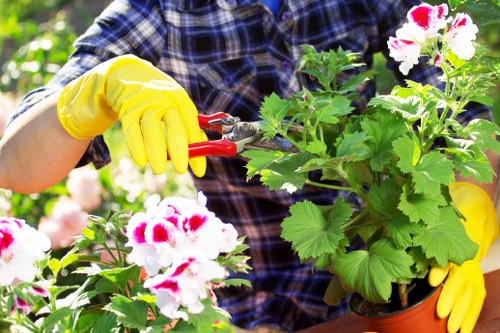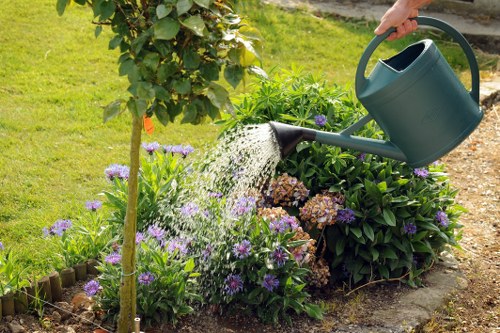Hedge Trimming in Temple
Introduction to Hedge Trimming in Temples

Maintaining the sanctity and aesthetics of temple grounds is paramount, and one of the essential aspects of this upkeep is hedge trimming. Hedges not only enhance the visual appeal of sacred spaces but also play a crucial role in defining boundaries and creating serene environments for worshippers.
In temples, hedge trimming is more than just a routine gardening task; it's a meticulous process that requires understanding the cultural, spiritual, and environmental significance of the plants involved. Proper trimming ensures that the hedges contribute positively to the temple's ambiance, promoting peace and tranquility.
The art of hedge trimming in temple settings involves a blend of traditional knowledge and modern horticultural practices. This balance ensures that the greenery remains healthy, well-shaped, and in harmony with the temple's architecture and landscaping design.
Importance of Hedge Trimming in Temple Landscaping

Hedge trimming serves multiple purposes in temple landscaping. Firstly, it maintains the neatness and orderliness of the grounds, which is essential for creating an inviting atmosphere for devotees and visitors.
Secondly, well-trimmed hedges act as natural barriers, providing privacy and shielding the temple from external disturbances. This separation helps in creating a secluded space conducive to meditation and prayer.
Furthermore, regular trimming promotes the health and longevity of the hedges. It prevents overgrowth, reduces the risk of diseases, and encourages robust growth, ensuring that the greenery remains vibrant and lush throughout the year.
Enhancing Aesthetic Appeal

The aesthetic aspect of hedge trimming cannot be overstated. In temples, where visual harmony is paramount, meticulously trimmed hedges complement the architectural elements and overall design theme.
Symmetrical and evenly shaped hedges contribute to the balance and beauty of the temple grounds, making the space more welcoming and spiritually uplifting for all who enter.
Additionally, creative trimming techniques can be employed to add artistic flair to the hedges, incorporating patterns or shapes that hold cultural or religious significance.
Preserving Cultural Significance

Hedges in temples often hold cultural and symbolic meanings. Proper trimming respects these traditions, ensuring that the plants are shaped in ways that reflect their intended significance.
This preservation of cultural symbols through horticultural practices reinforces the temple's role as a custodian of heritage, allowing visitors to connect with their spiritual roots through the natural environment.
Moreover, certain trimming techniques may be prescribed in religious texts or by temple authorities, making adherence to these guidelines essential for maintaining the sanctity of the space.
Techniques for Effective Hedge Trimming

Achieving well-trimmed hedges in temple settings requires a combination of proper techniques and tools. Here are some essential methods:
- Shaping: Determine the desired shape of the hedge, whether formal or informal, and trim accordingly to maintain consistency.
- Pruning: Remove dead or diseased branches to promote healthy growth and prevent the spread of infections.
- Thinning: Reduce the density of the hedge to allow light penetration and air circulation, which are vital for plant health.
- Maintenance: Regular trimming ensures that the hedges remain in optimal condition, preventing overgrowth and maintaining their intended appearance.
Using the right tools, such as hedge trimmers, pruning shears, and safety equipment, is essential for executing these techniques effectively and safely.
Seasonal Trimming Considerations
Seasonality plays a significant role in hedge trimming practices. Understanding the growth cycles of the plants helps in scheduling trims for maximum effectiveness.
In temples, timing the trimming process to align with religious festivals or specific seasons can enhance the overall spiritual experience, adding to the ceremonial preparations.
For instance, trimming during the dormant season can minimize stress on the plants, while summer trims can help manage excessive growth and maintain shape.
Integrating Sustainability in Hedge Trimming
Adopting sustainable practices in hedge trimming contributes to environmental conservation and the long-term health of the temple grounds.
- Organic Treatments: Use natural fertilizers and pest control methods to maintain plant health without harming the ecosystem.
- Water Conservation: Implement efficient watering systems and irrigation techniques to reduce water usage.
- Waste Management: Compost trimmed branches and leaves to recycle nutrients back into the soil, reducing waste.
These sustainable approaches ensure that the temple's greenery thrives while respecting the environment.
Selecting the Right Plants for Temple Hedges
The choice of plants for temple hedges is crucial, as it affects both the visual appeal and the maintenance requirements of the greenery.
Typically, evergreen species are favored for their year-round foliage, providing constant greenery and structure to the temple landscape.
Additionally, selecting native plants ensures that the hedges are well-suited to the local climate and soil conditions, reducing the need for extensive maintenance and promoting biodiversity.
Popular Plants for Temple Hedges
- Boxwood: Known for its dense foliage and ease of shaping, boxwood is a popular choice for formal hedges.
- Privet: Fast-growing and hardy, privet hedges provide quick coverage and can be trimmed into various shapes.
- Yew: With its dark green leaves and slow growth, yew is ideal for creating long-lasting, elegant hedges.
- Holly: Offering bright berries and glossy leaves, holly hedges add color and texture to temple grounds.
Choosing the right plant species enhances the overall beauty and functionality of the temple's landscape, ensuring that the hedges serve their intended purpose effectively.
Tools and Equipment for Hedge Trimming
Having the appropriate tools is essential for achieving precise and efficient hedge trimming in temple settings.
Some of the commonly used tools include:
- Electric or Gas Hedge Trimmers: For cutting through dense foliage and maintaining uniform shapes.
- Pruning Shears: Ideal for detailed trimming and shaping of smaller branches.
- Loppers: Used for cutting thicker branches that are beyond the capacity of pruning shears.
- Gloves and Protective Gear: Ensuring the safety of the gardeners during the trimming process.
Regular maintenance of these tools, such as sharpening blades and cleaning equipment, prolongs their lifespan and ensures optimal performance during hedge trimming tasks.
Safety Measures
Ensuring safety during hedge trimming is paramount, especially in the serene and sacred environment of a temple.
Gardeners should wear appropriate protective gear, including gloves, goggles, and sturdy footwear, to prevent injuries.
It's also important to handle tools carefully, follow manufacturer guidelines, and be mindful of the surroundings to avoid accidents.
Professional vs. DIY Hedge Trimming
While DIY hedge trimming might be feasible for smaller temples with limited greenery, larger temples often benefit from professional gardening services.
Professional gardeners bring expertise in horticulture, ensuring that the hedges are trimmed correctly and maintained according to the temple's specific needs.
Moreover, professionals can provide valuable advice on plant care, seasonal trimming, and sustainable practices, enhancing the overall quality and longevity of the temple's landscape.
Benefits of Regular Hedge Trimming in Temples
Regular hedge trimming offers numerous benefits, both aesthetic and practical, contributing to the temple's overall environment.
- Enhanced Appearance: Well-trimmed hedges create a visually appealing setting, reflecting the temple's dedication to beauty and order.
- Healthier Plants: Trimming removes diseased or damaged branches, promoting the health and vitality of the hedges.
- Improved Airflow and Light: Proper trimming allows better air circulation and light penetration, essential for plant growth.
- Increased Safety: Removing overgrown branches minimizes the risk of them obstructing pathways or causing accidents.
These benefits collectively ensure that the temple grounds remain a peaceful and inviting space for worship and reflection.
Long-Term Sustainability
Consistent hedge trimming contributes to the long-term sustainability of the temple's greenery. By maintaining plant health and preventing overgrowth, the hedges can thrive for many years, reducing the need for extensive replacements and minimizing maintenance costs.
Sustainable practices, such as composting trimmings and using eco-friendly tools, further enhance the environmental friendliness of the temple's landscaping efforts.
This commitment to sustainability aligns with the broader spiritual values of respect for nature and stewardship of the earth.
Creating a Tranquil Environment
The primary purpose of a temple is to offer a space for peace and contemplation. Well-maintained hedges contribute significantly to creating this tranquil environment.
They provide natural barriers that filter sound and create secluded areas for meditation. The sight of neatly trimmed greenery also has a calming effect, enhancing the overall spiritual experience of visitors.
Moreover, the rhythmic act of hedge trimming itself can be a meditative practice for the gardeners, fostering a deeper connection with nature and the sacred space.
Challenges in Hedge Trimming for Temples
While hedge trimming is essential, it presents certain challenges that need to be addressed to ensure effective maintenance.
One major challenge is balancing aesthetic preferences with the health of the plants. Over-trimming can stress the plants, making them susceptible to diseases and pests.
Additionally, limited resources and expertise can hinder proper trimming practices, especially in smaller temples with limited budgets.
Managing Time and Resources
Effective hedge trimming requires allocating sufficient time and resources. This includes scheduling regular maintenance sessions and investing in quality tools and equipment.
Temples can address this challenge by training volunteers or contracting professional services to handle trimming tasks, ensuring consistency and quality without overburdening the temple staff.
Prioritizing tasks and planning trimming activities around temple events can also help in managing resources efficiently.
Environmental Factors
Environmental factors such as weather conditions, pests, and diseases can impact the success of hedge trimming efforts.
Temples must monitor these factors closely and adopt preventive measures to protect their hedges. This includes implementing pest control strategies, applying appropriate fertilizers, and adjusting trimming schedules based on seasonal changes.
By staying proactive, temples can mitigate the adverse effects of environmental challenges and maintain healthy, beautiful hedges.
Best Practices for Hedge Trimming in Temples
Adhering to best practices ensures that hedge trimming in temples is performed effectively, maintaining both the beauty and health of the greenery.
- Regular Scheduling: Establish a consistent trimming schedule based on the growth patterns of the plants and seasonal changes.
- Proper Tool Maintenance: Keep all trimming tools clean and sharp to ensure precise cuts and reduce the risk of plant damage.
- Balanced Trimming: Avoid removing more than one-third of the plant's foliage in a single trimming session to prevent stress.
- Documentation: Keep records of trimming activities, plant health observations, and any issues encountered to inform future maintenance strategies.
Implementing these practices fosters a sustainable and harmonious environment within the temple grounds.
Training and Education
Providing training and education for those responsible for hedge trimming ensures that they possess the necessary skills and knowledge.
Workshops, instructional materials, and hands-on training sessions can equip gardeners with the expertise to perform trimming tasks effectively and safely.
Additionally, staying informed about the latest horticultural developments and sustainable practices can enhance the quality of hedge maintenance.
Collaboration with Horticultural Experts
Collaborating with horticultural experts or landscape designers can bring valuable insights into optimal hedge trimming techniques and plant selection.
Experts can conduct assessments of the temple grounds, recommend suitable plant species, and devise tailored trimming strategies that align with the temple's specific needs and aesthetic goals.
This collaboration ensures that the hedges are maintained to the highest standards, contributing positively to the temple's overall environment.
Case Studies: Successful Hedge Trimming in Temples
Examining successful hedge trimming practices in other temples can provide inspiration and practical insights for maintaining temple greenery.
The Serenity Temple
Located in a bustling city, the Serenity Temple has maintained a tranquil atmosphere through meticulous hedge trimming practices. By scheduling regular trims and employing sustainable gardening methods, the temple ensures that its hedges remain lush and well-shaped throughout the year.
Harmony Ashram
The Harmony Ashram emphasizes the spiritual connection between gardeners and nature. Their hedge trimming process incorporates meditation and mindfulness practices, fostering a deeper appreciation for the natural beauty of the hedges and their role in the ashram's environment.
The Green Sanctuary
The Green Sanctuary temple integrates modern technology with traditional trimming techniques. Automated irrigation systems and eco-friendly tools streamline their hedge maintenance, allowing gardeners to focus on precise trimming and artistic shaping of the hedges, enhancing the temple's aesthetic appeal.
These case studies highlight the importance of dedicated maintenance schedules, sustainable practices, and the integration of cultural values in successful hedge trimming efforts.
Conclusion
Hedge trimming in temple settings is a vital component of landscape maintenance, contributing to the sacred space's beauty, serenity, and functionality. By employing proper techniques, selecting suitable plants, and adhering to sustainable practices, temples can ensure that their hedges remain healthy and visually appealing year-round.
Overcoming challenges such as resource limitations and environmental factors requires careful planning, training, and possibly professional assistance. Embracing best practices and learning from successful case studies can further enhance the effectiveness of hedge trimming efforts.
Ultimately, well-maintained hedges enhance the spiritual ambiance of the temple, providing a peaceful sanctuary for worshippers and visitors alike.
Contact us today to learn more about our hedge trimming services tailored specifically for temple landscapes. Let us help you maintain the sanctity and beauty of your sacred space.
